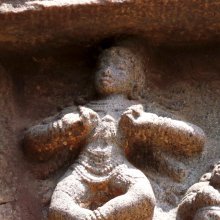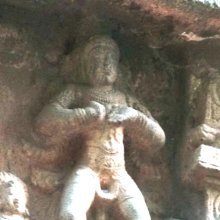Sthitavarta, Sthitāvartā: 2 definitions
Introduction:
Sthitavarta means something in Hinduism, Sanskrit. If you want to know the exact meaning, history, etymology or English translation of this term then check out the descriptions on this page. Add your comment or reference to a book if you want to contribute to this summary article.
Images (photo gallery)
In Hinduism
Natyashastra (theatrics and dramaturgy)
Source: Wisdom Library: Nāṭya-śāstraSthitāvartā (स्थितावर्ता) refers to a one of the thirty-two cārīs, according to the Nāṭyaśāstra chapter 11. The Sthitāvartā-cārī is classified as a bhaumī, or “earthly”, of which there are sixteen in total. The term cārī refers to a “dance-step” and refers to the simultaneous movement of the feet (pāda), shanks (jaṅghā) and the hip (ūru). From these cārīs proceed dance as well as movements in general.
Source: archive.org: Natya ShastraSthitāvartā (स्थितावर्ता).—A type of earthly (bhaumī) dance-step (cārī);—Instructions: one Agratalasañcara foot drawn up to cross the remaining foot and this movement repeated with another foot after separating the two.

Natyashastra (नाट्यशास्त्र, nāṭyaśāstra) refers to both the ancient Indian tradition (shastra) of performing arts, (natya—theatrics, drama, dance, music), as well as the name of a Sanskrit work dealing with these subjects. It also teaches the rules for composing Dramatic plays (nataka), construction and performance of Theater, and Poetic works (kavya).
See also (Relevant definitions)
Ends with: Susthitavarta.
Full-text: Carin.
Relevant text
Search found 2 books and stories containing Sthitavarta, Sthitāvartā; (plurals include: Sthitavartas, Sthitāvartās). You can also click to the full overview containing English textual excerpts. Below are direct links for the most relevant articles:
Gati in Theory and Practice (by Dr. Sujatha Mohan)
Gati in Maṇipurī < [Chapter 4 - Practice of Gati]
Natyashastra (English) (by Bharata-muni)

